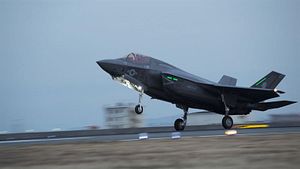As Franz-Stefan Gady has already covered, the United States has approved Singapore’s request to acquire four F-35B “Panther” Joint Strike Fighters, with an option for acquiring eight more. Singapore becomes the 12th country to acquire the F-35, and the fourth (behind the United States, the U.K., and Japan) to acquire the “B” variant. As a very small but very wealthy and technologically advanced country, the idea of Singapore acquiring a relatively small number of advanced, expensive fighters makes intuitive sense. Moreover, acquisition of the F-35 is in line with the long-term defense relationship between Singapore and the United States, which has supplied previous generations of fighter aircraft. Nevertheless, the purchase bears some additional scrutiny, based especially on the decision to go with the F-35B short take-off/vertical landing (STOVL) variant, rather than the F-35A.
Historically, the desire for vertical and/or short take-off and landing (VSTOL) capabilities was driven first by concerns over the availability of runway space during a general conflict. NATO planners feared that Soviet tactical nuclear weapons (and later, precision-guided conventional ballistic missiles) would destroy airbases, necessitating the use of shorter, less advanced landing and takeoff areas. Germany, not known for its interest in flat-decked carriers, was among the first to invest heavily in VSTOL efforts.
In this context, it’s not at all difficult to see Singapore’s interest in the aircraft. Singapore already trains and quarters much of its air force abroad, mostly due to a lack of space in and around the country. While the F-35B doesn’t eliminate that problem entirely, it does simplify some operational problems during periods of conflict, while complicating the calculation that any enemy might have in trying to neutralize Singapore’s air force.
It is also possible, although perhaps less likely, that Singapore could use the F-35B from an amphibious platform. Singapore currently operates four Endurance-class landing platform docks, ships of some 7,000 tons with a short landing area aft. Even with modification, these ships are too small to operate the F-35B in militarily useful fashion, although there has been some discussion of a longer, fully flat-decked variant that could conceivably carry the Panther. Singapore certainly has the resources to invest in such a ship, and could follow Japan and South Korea in adapting small ships into F-35B carriers. The strategic logic would need to be more fully worked out, however, before such an acquisition would make any sense.
In any case, the acquisition of the F-35 ensures that Singapore will fly the most advanced fleet of fighters in its region, and that its security relationship with the United States remains secure. Singapore’s acquisition will likely boost prospects of the F-35 and the B variant in particular, with Spain, Italy, South Korea, and Australia remaining the most likely future customers.

































